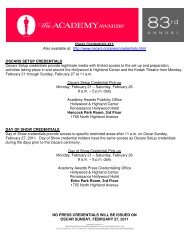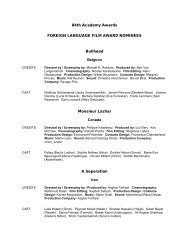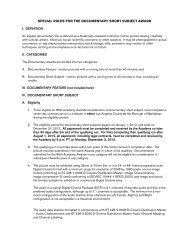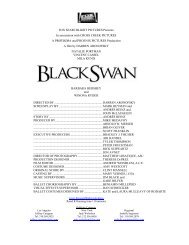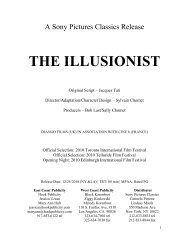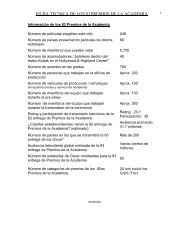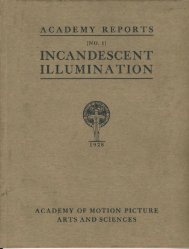FOX SEARCHLIGHT PICTURES Presents An AD HOMINEM ...
FOX SEARCHLIGHT PICTURES Presents An AD HOMINEM ...
FOX SEARCHLIGHT PICTURES Presents An AD HOMINEM ...
You also want an ePaper? Increase the reach of your titles
YUMPU automatically turns print PDFs into web optimized ePapers that Google loves.
To capture the islands as they are today – as rife with developers and suburbia as they are with<br />
laid-back surfers and Polynesian traditions -- with a fresh eye, Payne reunited with director of<br />
photography Phedon Papamichael, who previously worked with him on SIDEWAYS. As soon as he<br />
read the script, Papamichael knew it was going to be something different. ―It was a very dialoguedriven<br />
story, which usually means the film will be less visual,‖ he begins. ―But in the case, the opposite<br />
was true. Because of the way the Hawaiian setting is juxtaposed with the King family‘s struggles, the<br />
visuals take on a major role. It was going to be very important to capture the beauty and nature of the<br />
surrounding environment so you can understand the conflict Matt feels over selling his family‘s land.‖<br />
Papamichael divided the film between two Hawaiis: the more hectic, citified Hawaii of<br />
Honolulu and the stunning, natural Mecca of Hanalei Bay on the island of Kauai, draped with verdant,<br />
tropical rainforests and surrounded by sapphire seas.<br />
―We really wanted to give a feeling for the community in Honolulu but also the beauty of the<br />
coast so you understand what could be lost and the connection to history that is there. That‘s why we<br />
decided to shoot wide-screen, which Alexander has only done once before, on ELECTION,‖ he<br />
explains. ―We decided that it would be a lot of fun to have that epic frame with these small, human<br />
figures confronted with the majesty of the landscape.‖<br />
At the same time, both men wanted the film to stay true to Payne‘s distinctively unadorned<br />
style, which is almost an anti-style. ―I like to bring an almost documentary style to fiction filmmaking,‖<br />
says Payne. ―It gives the story a sense of reportage.‖<br />
Papamichael concurs. ―With Alexander, one of the biggest assignments is always to make sure<br />
the photography doesn‘t get in the way of the story. He really loves realism, to the point that if we go<br />
to a location and there are tree trimmers working nearby, he says ‗great‘ and he embraces that as part of<br />
what‘s going on in the scene,‖ he explains. ―Or, for example, when we shot in the bar where George<br />
Clooney meets Beau Bridges, it was very important to Alexander to have the real locals who frequent<br />
the place be in there to get that feel of reality. The same goes for lighting. It‘s always very natural, to<br />
the point that the audience should never realize that they‘re watching a crafted film.‖<br />
He continues, ―We really want the audience to be taken in by the characters without distraction.<br />
The emotions are so intense and the writing so strong, we don‘t need to add visual drama.‖<br />
Hawaii, however, often brought its own drama. ―The light there is challenging because it is<br />
constantly changing,‖ notes Papamichael. ―It can go from overcast to sunny in the time frame of one<br />
shot. Fortunately, both Alexander and George, being a filmmaker himself, are very good at reacting in<br />
the moment so you can switch scenes around. It gave us a lot of flexibility.‖<br />
14




